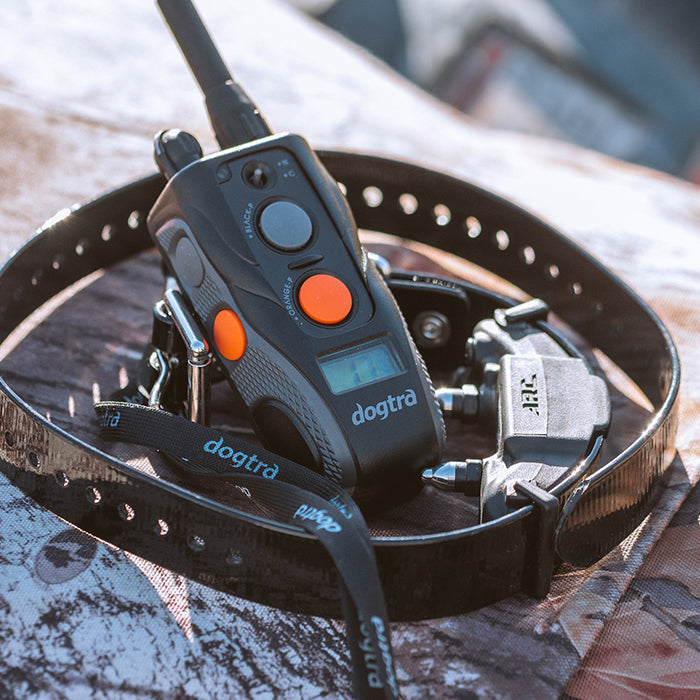4 EASY E-COLLAR TRAINING TIPS FOR A WELL-BEHAVED DOG

Teaching your dog new tricks can be a fun and rewarding experience, but it can also be a challenge. E-Collars provide a safe and effective way to train your dog and reinforce positive behaviors. However, it's essential to use them correctly to avoid causing harm or discomfort to your pet. In this article, we'll share four simple E-Collar training tips that any dog owner can use to help their canine become a well-behaved and happy companion. These tips are easy to follow and designed to make E-Collar training a positive experience for both you and your pup.
When You Should Start E-Collar Training
E-Collar training can be a useful tool for teaching your dog new commands and reinforcing positive behaviors. However, it's important to start at the right time to avoid causing harm or discomfort to your pet. Experts recommend waiting until your dog is at least six months old before starting E-Collar training. This allows your dog to develop and mature physically and mentally, making them better able to understand and respond to training commands. Additionally, it's important to ensure that your dog has received basic obedience training before introducing E-Collars. This helps establish a foundation of trust and understanding between you and your pet, making the training process more effective and less stressful for both of you.
Four E-Collar Training Tips for Beginners
Remote collar training can be an effective way to teach your dog new commands and reinforce positive behaviors. However, it's important to use E-Collars correctly to avoid causing harm or discomfort to your furry friend. Here are the four E-Collar training tips that are perfect for beginners.
1. Make Sure Your Dog Understands Basic Commands
Before adding an e-collar to any behavior, first, make sure your dog knows that behavior 100%.
As an example, when I begin teaching the e-collar with the “sit” command. I need to make sure my dog can successfully sit with only the cue. That means no food lures! No cheating here. If your dog doesn’t know the behavior inside and out it is unfair to ask them to do it when stimulation is added.
When you begin using the e-collar, it is extremely important to have your dog on a leash. The leash is our safety net, which is used to guide the dog to the command as the e-collar is used for reinforcement. Our goal is to eventually wean the dog off of the leash and give our dog freedom with the e-collar. Remember, the e-collar is used to reinforce commands the dog already knows. Three commands that will be very important to reinforce are recall, stationary behavior, and place behavior.
2. Understand How to Use the Equipment
E-Collars can be an effective training tool for dogs when used correctly. However, it's crucial to understand how to use a remote collar before incorporating it into your training routine. Here is what you need to understand before you buy an e-collar:
- How to turn the dial to increase/decrease static stimulation produced.
- Nick Button: By pressing the nick button, you give the dog a very brief burst of stimulation that is less than a 1/4 second duration long, regardless of how long you depress the button.
- Continuous Button: The continuous button delivers constant stimulation for as long as the button is depressed.
- The Continuous and Pager buttons have a safety shut-off if it is pressed for more than 12 seconds.
- How to hold the transmitter comfortably in either hand, but make sure not to touch the antenna or have the transmitter in your pocket, as this will impede the radio signal and give you inconsistent stimulation.
3. Get Familiar with an E-Collar & Practice
Getting familiar with an e-collar and practicing its proper usage can help pet owners train their dogs more effectively and efficiently. Here are some tips that will help you understand your equipment better:
- Get your hands moving around the transmitter and understand the buttons long before placing the unit on your dog.
- Practicing our skills with the transmitter and focusing on timing is of utmost importance.
- Set up the following drill in your home: assign one person to role play as your dog, ask that person for behavior, and give them 1-2 seconds to understand the word you said. If they have not performed the behavior in that time frame, press and hold the Nick or Continuous button, release the button once the person begins to do the correct behavior.
- Something that can be very helpful with this drill is the use of a sound box! The sound box will be connected to your transmitter and make a beeping noise when the stim is applied. This is a great way to help sharpen our timing!
4. Ensure a Proper Fit
When using an E-Collar for dog training, ensuring a proper fit is crucial for both safety and effectiveness. The collar should fit snugly around the dog’s neck, with the two contact points touching your dog’s skin at all times.
- The collar should not be able to move freely around the dog’s neck.
- It may help to clip a portion of hair to ensure the proper position of the contact points. For dogs with long/thick coats, you can clip some of the coat in the area where the receiver will be placed.
- The hair will wad up under the contacts and work as an insulator and thus preventing consistent contact with the dog’s skin.
Final Thoughts
Incorporating E-Collar training into your dog's routine can be a great way to teach them new commands and reinforce positive behaviors. However, it's important to use E-Collars correctly and safely to avoid causing harm or discomfort to your furry friend. By following the four E-Collar training tips outlined in this article, you'll be well on your way to raising a well-behaved and happy companion. Remember to start training at the right time, ensure a proper fit, use positive reinforcement, and keep sessions short and focused. With patience, consistency, and love, you and your pup can build a strong and trusting relationship while enjoying the benefits of effective E-Collar training. Remember... practice makes perfect, but perfect practice makes for perfect performance!





